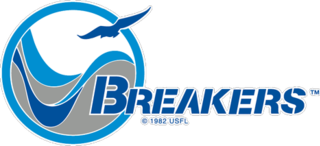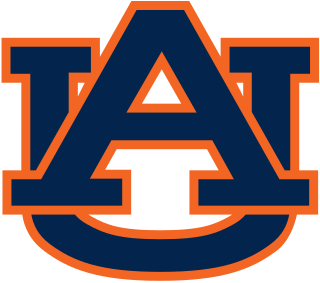
The United States Football League (USFL) was a professional American football league that played for three seasons, 1983 through 1985. The league played a spring/summer schedule in each of its active seasons. The 1986 season was scheduled to be played in the autumn/winter, directly competing against the long-established National Football League (NFL). However, the USFL ceased operations before that season was scheduled to begin.

The Portland Breakers were an American football team that played in the United States Football League (USFL) in the mid-1980s. Before moving to Portland, Oregon, the franchise was previously in Boston, Massachusetts as the Boston Breakers and New Orleans, Louisiana as the New Orleans Breakers.
The Pittsburgh Maulers were a team that competed in the 1984 season of the United States Football League. Their most prominent player was first pick overall in the 1984 USFL Draft, running back Mike Rozier of Nebraska, who won the Heisman Trophy, collegiate football's most prestigious individual award.

The Tampa Bay Bandits were a professional American football team in the United States Football League (USFL) which was based in Tampa, Florida. The Bandits were a charter member of the USFL and was the only franchise to have the same principal owner, head coach, and home field during the league's three seasons of play (1983–1985). The Bandits were one of the most successful teams in the short-lived spring football league both on the field and at the ticket booth. Spurrier's "Bandit Ball" offense led them to three winning seasons and two playoff appearances, and their exciting brand of play combined with innovative local marketing helped the Bandits lead the league in attendance. However, the franchise folded along with the rest of the USFL when the league suspended play after the 1985 season.
The Birmingham Stallions were a franchise in the United States Football League, an attempt to establish a second professional league of American football in the United States in competition with the National Football League. They played their home games at Birmingham, Alabama's Legion Field. They competed in all three USFL seasons, 1983–1985. During their run, they were one of the USFL's more popular teams, and seemed to have a realistic chance of being a viable venture had the USFL been better run.
The Denver Gold was a franchise in the United States Football League, an attempt to establish a second major professional football league in the United States, playing a springtime season, from 1983 to 1985. The Gold played their home games at Mile High Stadium in Denver, Colorado; and were co-tenants in the spring with the Triple-A Denver Zephyrs baseball team.
The San Antonio Gunslingers were a professional American football team based in San Antonio, Texas, that played in the United States Football League (USFL) in 1984 and 1985. Owned by oil magnate Clinton Manges, the team played its home games in Alamo Stadium and its colors were kelly green, royal blue, silver, and white. Rick Neuheisel was the team's quarterback.
The 2001 CFL season is considered to be the 48th season in modern-day Canadian football, although it is officially the 44th Canadian Football League season.
The 1988 CFL season is considered to be the 35th season in modern-day Canadian football, although it is officially the 31st Canadian Football League season.
The 1987 CFL season is considered to be the 34th season in modern-day Canadian football, although it is officially the 30th Canadian Football League season.
The 1986 CFL season is considered to be the 33rd season in modern-day Canadian football, although it is officially the 29th Canadian Football League season.
The 1988 Los Angeles Rams season was the franchise's 51st season in the National Football League, their 41st overall, and their 43rd in the Greater Los Angeles Area. The team improved on a disappointing 6–9 record the previous year, going 10–6 and qualifying as a Wild Card before losing to the Minnesota Vikings in the NFC Wild Card game.
The 2009 CFL season was the 56th season of modern-day Canadian football. Officially, it was the 52nd season of the Canadian Football League. The Montreal Alouettes won the 97th Grey Cup on November 29 with a last second 28–27 win over the Saskatchewan Roughriders. The 19-week regular schedule, issued February 3, 2009, began on July 1, which was only the second time in league history that a CFL season started on Canada Day, with the first occurring in 1998. The playoffs started on November 15 and two weeks of pre-season games began on June 17.

The Seattle Mist were a team in the Legends Football League that were founded as part of the Lingerie Bowl's expansion into a full-fledged league in 2009. They played their home games at the ShoWare Center in Kent, Washington. The league, originally named the Lingerie Football League, rebranded in 2013 and shifted away from Super Bowl halftime shows. The Mist won three championships, known as the Legends Cup.

Southern Districts Oilers are a Gridiron team from Adelaide in the State of South Australia in Australia. They play in the South Australian Gridiron Association league.

The 2011 Auburn Tigers football team represented Auburn University in the 2011 NCAA Division I FBS football season. The team was coached by Gene Chizik, who was in his third season with Auburn. The Tigers played their home games at Jordan–Hare Stadium in Auburn, Alabama, and competed in the Western Division of the Southeastern Conference (SEC). The Tigers entered the 2011 season after winning the 2011 BCS National Championship. Auburn finished the year 8–5 overall and 4–4 in SEC play to place fourth in the Western Division. They were invited to the Chick-fil-A Bowl, where they defeated Virginia, 43–24.

The 2022 USFL season was the inaugural season of the United States Football League, and the first season of a league using that name since 1985. The season began on April 16 and concluded on July 3. The league's eight teams represent various geographical locales and associated team names that were part of the 1984 season of the original USFL. For 2022, all regular-season games were played in Birmingham, Alabama, at Protective Stadium and at Legion Field.
The 2023 New Orleans Breakers season was the New Orleans Breakers' second season in the United States Football League, their second at Protective Stadium, and their first under the head coach/general manager tandem of John DeFilippo and Ryan Jones. For the 2023 season, they improved upon their 6–4 record from the previous season by going 7–3, and lost to the Birmingham Stallions in the USFL South Division Championship Game for the second straight year. This time with the final score being 47–22 in favor of Birmingham.

The team started out in 1983 as the Boston Breakers, owned by Boston businessman George Matthews and former New England Patriots wide receiver Randy Vataha. However, finding a stadium proved difficult. The lack of a professional-quality stadium had stymied previous attempts at pro football in Boston before the Patriots arrived in 1960.







